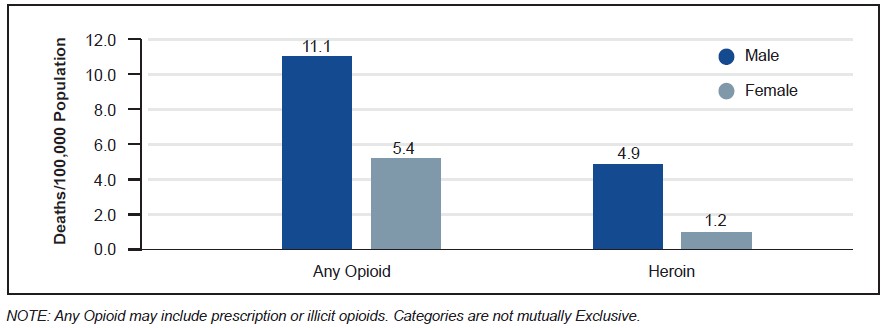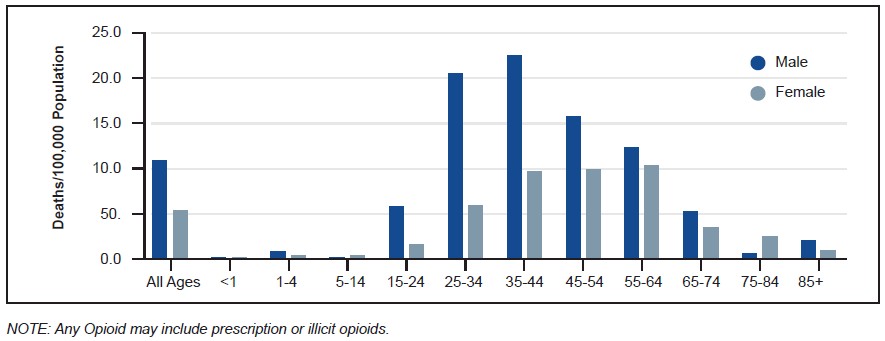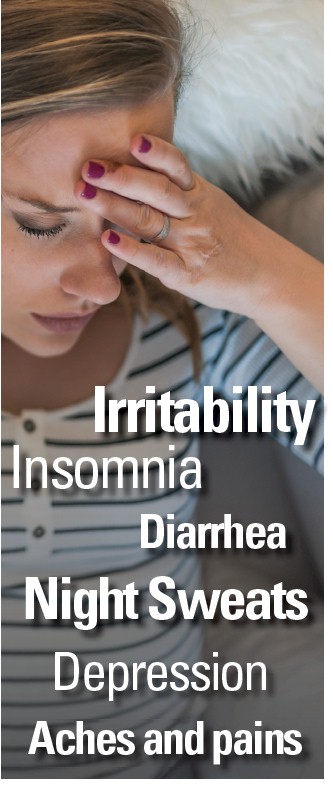Lesson 5
Lesson 6 Module 2
Introduction
In this module, we will focus on the important issue of opioid use during pregnancy. Opioids are a class of drugs that can be very dangerous if misused. Many times, opioid use begins with the prescribing of an opioid for pain relief. For example, doctors may give people opioids after a surgery or an injury to treat their pain. Opioids act on the body’s opioid receptors and include heroin as well as drugs such as morphine, hydrocodone and oxycodone, fentanyl and methadone. These are examples of prescription drug names, but opioids also have many other nicknames such as Oxy or Percs. Prescription opioids are used medically to relieve moderate to severe pain and while they provide relief, they can also lead to problems with misuse.
Opioid use in a young woman of childbearing age can be especially concerning. Many young women of reproductive age have filled a prescription for an opioid pain medication within the past year. If used during pregnancy, opioids can cause issues in a newborn such as Neonatal Abstinence Syndrome, or NAS.
Let’s review opioids and young women, and spend some time focusing on what we know about opioid use during pregnancy.

Increase in Opioid Use in Georgia
You’ve probably heard about the opioid epidemic in our country. There is also an issue with opioid use in our own state.
Beginning in 2013, illicit opioids (e.g., heroin and fentanyl) drove the sharp increase in opioid-involved overdose deaths as you can see in the graph below.
Opioid Overdose Deaths by Drug Type and Year, Georgia 2010-2019 (1)

NOTE: Any Opioid may include prescription or illicit opioids. Categories are not mutually exclusive.
Did You Know:
From 2010 to 2019, the number of opioid-involved overdose deaths increased by 78%, from 514 to 913.
Heroin-Involved Overdoses in Georgia
In 2019, emergency department visits for heroin involved overdoses increased by 5% from the
previous year.2 In total, heroin-involved overdoses accounted for 1,416 emergency department visits, 339 hospitalizations, and 307 deaths. (3)

Opioid Overdose Death Rates by Sex
Males were 1.6 times more likely to die from any opioid involved overdose, and 4.1 times more likely to die from a heroin involved overdose than females.
Opioid Overdose Death Rates by Sex, Georgia 2019 (5)

NOTE: Any Opioid may include prescription or illicit opioids. Categories are not mutually exclusive.
Opioid Overdose Death Rates by Age
Males aged 35-44 years died from opioid involved overdose more frequently than persons of any other age category, and were 2.1 times more likely to die from an overdose than females of the same age.
Any Opioid Overdose Death Rates by Age and Sex, Georgia 2019 (5)

In the chart above we can also see women's opioid overdose death rates steadily increase from age 15 to around mid-40s. These are all years when it is possible for most women to become pregnant. The choices you make now may impact your future patterns of opioid use and risk for overdose.

Discuss:
There are high rates of overdose deaths in the age categories of 25-34 and 35-44 years, periods of time when women are able and do have babies.
Opioid Overdose Emergency Department Visit Rates by Sex and Age
This chart shows opioid overdose emergency department visit rates which begin to rise, and peak for the first time, for women in their prime childbearing years.
Opioid Overdose Emergency Department Visit Rates by Sex and Age, Georgia 2019 (6)


Discuss:
What do you think about these rates? Any ideas about why rates may increase or decrease across a young woman’s life?

Discuss:
What about the male-female differences? What do you think the main drivers of these differences might be?
Opioid Deaths and Other Drugs
To further complicate things, many times when a young woman dies from an opioid overdose there are more drugs in her system than just an opioid.
Many times when a woman is struggling with a substance use disorder, it is actually a polysubstance use issue. The latest information from CDC (Centers for Disease Control and Prevention) really highlights that many opioid overdoses also involved cocaine, while others also involved drugs called benzodiazepines.7 Benzodiazepines include drugs you have probably heard of like Xanax, Valium, Klonopin, and Versed.
Combining opioids and another central nervous depressant, like a benzodiazepine, is a particularly dangerous combination for a young woman. These type of drugs are dangerous because they make it hard for your body to breathe normally. It is a key driver of overdose deaths for this group.


Discuss:
Combining opioids and any other drug is dangerous, and is a key driver of overdose deaths for young women.
Withdrawal Symptoms in Adults
You may be familiar with what withdrawal looks like in an adult – there are a lot of symptoms that are concerning. Many are extremely uncomfortable for the user, but some withdrawal symptoms can be deadly.
Not only adults struggle with withdrawal from opioids when they stop use – when a pregnant woman uses opioids, she is exposing her fetus to opioids as well. In our country and state, this has become an increasing issue to be concerned about.

Did You Know:
A newborn can be affected by mom’s
opioid use during pregnancy.
